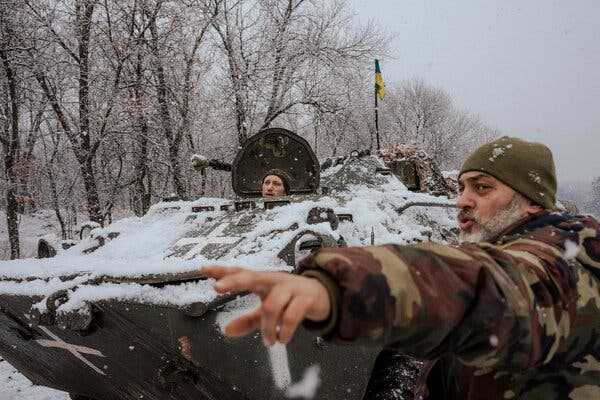Classified documents detailing secret American and NATO plans have appeared on Twitter and Telegram.
-
Send any friend a story
As a subscriber, you have “>10 gift articles to give each month. Anyone can read what you share.
Give this article

The leak documents do not provide specific battle plans but they offer a snapshot of time — the American and Ukrainian view, as of March 1, of what Ukrainian troops might need for the campaign.
WASHINGTON — Classified war documents detailing secret American and NATO plans for building up the Ukrainian military ahead of a planned offensive against Russia were posted this week on social media channels, senior Biden administration officials said.
The Pentagon is investigating who may have been behind the leak of the documents, which appeared on Twitter and on Telegram, a platform with more than half a billion users that is widely available in Russia.
Military analysts said the documents appear to have been modified in certain parts from their original format, overstating American estimates of Ukrainian war dead and understating estimates of Russian troops killed.
The modifications could point to an effort of disinformation by Moscow, the analysts said. But the disclosures in the original documents, which appear as photographs of charts of anticipated weapons deliveries, troop and battalion strengths, and plans, represents a significant breach of American intelligence in the effort to aid Ukraine.
Biden officials were working to get them deleted but had not, as of Thursday evening, succeeded.
“We are aware of the reports of social media posts and the department is reviewing the matter,” said Sabrina Singh, the deputy press secretary at the Pentagon.
The State of the War
- China Under the Spotlight: Beijing’s role in pressing Russia to end the war in Ukraine was expected to be a main topic of discussion during a three-day trip to China by Emmanuel Macron, the president of France, and Ursula von der Leyen, the president of the European Commission.
- Zelensky in Poland: On his first official visit to Poland, President Volodymyr Zelensky of Ukraine won strong backing from Polish leaders for his country’s rapid entry into NATO and signed a deal paving the way for the joint production of arms and ammunition.
- Finland’s Entry to NATO: The Nordic country officially became the military alliance’s 31st member, in what amounts to a strategic defeat for President Vladimir Putin of Russia.
- Drone Warfare: Using aerial drones to spot the enemy and direct artillery fire has become a staple of war for Ukraine and Russia, especially in the fiercely contested city of Bakhmut.
The documents do not provide specific battle plans, like how, when, and where Ukraine intends to launch its offensive. And because the documents are five weeks old, they offer a snapshot of time — the American and Ukrainian view, as of March 1, of what Ukrainian troops might need for the campaign.
To the trained eye of a Russian war planner, field general or intelligence analyst, however, the documents no doubt offer many tantalizing clues. The documents mention, for instance, the expenditure rate of HIMARS — American-supplied high mobility artillery rocket systems, which can launch attacks against targets like ammunition dumps, infrastructure and concentrations of troops, from a distance. The Pentagon has not said publicly how fast Ukrainian troops are using the HIMARs munitions; the documents do.
It was unclear how the documents ended up on social media. But pro-Russian government channels have been sharing and circulating the briefing slides, military analysts said.
The analysts warned that documents released by Russian sources could be selectively altered to present the Kremlin’s disinformation.
“Whether these documents are authentic or not, people should take care with anything released by Russian sources,” said Michael Kofman, the director of Russian studies at CNA, a research institute in Arlington, Va.
One of the slides said 16,000 to 17,500 Russian soldiers had been killed while Ukraine had suffered as many as 71,500 troop deaths. The Pentagon and other analysts have estimated that Russia has suffered far more casualties, and that closer to 200,000 soldiers on each side had been killed or wounded.
Nonetheless, analysts said parts of the documents appeared authentic and provide Russia with valuable information such as the timetables for the delivery of weapons and troops, Ukrainian troop buildup numbers and other military details.
A document labeled “top secret” offers the “Status of the Conflict as of 1 Mar.” On that day, Ukrainian officials were at an American base in Weisbaden, Germany, for war game sessions, and a day later, Gen. Mark A. Milley, the chairman of the Joint Chiefs of Staff, and Gen. Christopher Cavoli, the supreme allied commander for Europe, visited the sessions.
Another document includes columns that list Ukrainian troop units, equipment and training, with schedules for January through April. The document contains a summary of 12 combat brigades that are being assembled, with nine of them apparently being trained and supplied by the United States and other NATO allies. Of those nine brigades, the documents said that six would be ready by March 31 and the rest by April 30. A Ukrainian brigade has about 4,000 to 5,000 soldiers, analysts said.
The document said that equipment delivery times would impact training and readiness in order to meet the timeline. Total equipment needed for nine brigades, the document said, was more than 250 tanks and more than 350 mechanized vehicles.
The leak is the first Russian intelligence breakthrough that has been made public since the war began. Throughout the war, the United States has provided Ukraine with information on command posts, ammunition depots and other key nodes in the Russian military lines. Such real-time intelligence has allowed the Ukrainians to target Russian forces, kill senior generals and force ammunition supplies to be moved farther from the Russian front lines, though U.S. officials say Ukraine has played the decisive role in planning and execution of those strikes.
But early on during the war, Ukrainian officials were hesitant about sharing their battle plans with the United States, for fear of leaks, American and European officials said. As recently as last summer, American intelligence officials said they often had a better understanding of Russia’s military plans than of Ukraine’s.
The intelligence sharing between Ukraine and the United States loosened up considerably last fall, and the two countries have been working closely on options for a Ukrainian offensive.
Thomas Gibbons-Neff contributed reporting.
Source: nytimes.com



